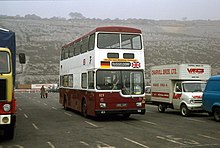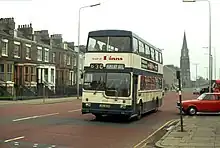Scania Metropolitan
The Scania Metropolitan was the first double decker bus model built jointly by MCW and Scania. It was built between 1973 and 1978.
| Scania Metropolitan | |
|---|---|
.jpg.webp) Preserved former London Transport Scania Metropolitan in April 2015 | |
| Overview | |
| Manufacturer | MCW |
| Body and chassis | |
| Doors | 1-2 |
| Floor type | Step entrance |
| Chassis | Scania BR111DH |
| Powertrain | |
| Engine | Scania D11 |
| Dimensions | |
| Length | 31 ft 10 in (9.7 m)[1] |
It was the second bus model jointly built by these two companies. The first model was the Metro-Scania single decker based on the BR110/CR110 chassis, which was the first Scania bus built for the United Kingdom market in 1969 and sold in small numbers.
Construction
The Metropolitan was the double deck equivalent of the Metro-Scania. It was based on Scania BR111DH chassis and the body was constructed by MCW, who claimed it to be built with 70% British content.[1] The distinguishing feature is the asymmetric windscreen being deeper on the nearside to give the driver an improved view of the kerb, a feature which was carried over to the MCW Metrobus. It was noted for its performance from the turbocharged Scania engine when compared to the earlier Gardner and Leyland diesel engine used in many buses of the time, its smooth and quiet ride due to air suspension, and high fuel consumption, particularly an issue for operators when the price of fuel rose during the 1973 oil crisis.[2] However, severe body corrosion and mechanical problems led these buses to have a short life in service.[1][3]
Operators


%252C_Showbus_2010_(2).jpg.webp)
London Transport was the largest operator of Scania Metropolitans, with 164 being delivered between 1975 and 1977. The Metropolitans were allocated to garages in South East London, later known as the Selkent operating district, but were all put up for sale in 1982 as part of wide-ranging cuts to London Transport bus services.[4][5] Some continued in service with other operators for several years, including Reading Transport, Whippet Coaches,[6][7] Charles Cook of Biggleswade, Black Prince Buses of Morley, Alec Head of Lutton and Camms of Nottingham.
Outside London, the Scania Metropolitan was popular with four out of five of the United Kingdom's passenger transport executives. However, they lived short lives with these operators due to reliability and fuel cost issues and were mostly withdrawn prior to bus deregulation in 1986. The Tyne & Wear Passenger Transport Executive were the second-largest operator of Metropolitans, purchasing 140 of the type from 1975 to 1977. Most of these Metropolitans were withdrawn and sold for scrap due to corrosion issues, although a handful passed to the PTE's successor Busways Travel Services.[8]
Other large orders for the Metropolitan from the passenger transport executives included the West Yorkshire Passenger Transport Executive, who purchased 95 Metropolitans between 1975 and 1977,[1] the Merseyside Passenger Transport Executive, who purchased 60 in the mid-1970s after taking delivery of 20 Metro-Scanias between 1972 and 1973,[9] and the Greater Glasgow Passenger Transport Executive, who purchased 40 Metropolitans in 1975.[10] Smaller orders were delivered to Greater Manchester PTE, who purchased 10 Metropolitans in 1974 for use on the Trans-Lancs Express service 400 connecting Bolton to Stockport,[10] and South Yorkshire PTE, who purchased four Metropolitans in 1975, which were sold in 1980 due to reliability issues and high operating costs.[11]
The Scania Metropolitan was also popular with municipally-owned bus companies across the United Kingdom. Leicester City Transport was the largest of these, purchasing 68 Metropolitans in several batches between 1974 and 1977 to operate alongside their 35 single-deck Metro-Scanias, with all but a final batch of five Metropolitans in 1977 being delivered in dual-door configuration.[12] Reading Transport, meanwhile, took 33 Metropolitans from 1975 to 1978, adding to these second-hand examples from the London Transport and Tyne & Wear Transport fleets,[6] Kingston upon Hull City Transport took 30 Metropolitans from 1975 to 1978, later adding second-hand Metropolitans from Merseyside Transport to their fleet,[13] and Newport Transport bought 10 Metropolitans in 1975, which were withdrawn from service in 1985.[14]
The only Scania Metropolitans to be purchased by a subsidiary of the National Bus Company were purchased by Maidstone & District Motor Services in 1975, with five delivered for comparative trials alongside Bristol VRTs and Volvo Ailsa B55s. When trials began in 1976, these Metropolitans were based at Hastings before being onto Chatham in 1977, and despite proving popular with both Maidstone & District staff and passengers, proved more expensive to run compared to the Bristol and Volvo buses, and would be withdrawn by 1983.[1][15]
China Motor Bus of Hong Kong were the only bus operator outside the United Kingdom to purchase Metropolitans, taking delivery of two examples in 1975,[16] which were withdrawn in the late 1980s.[17]
End of production
Production of the Scania Metropolitan ceased in 1978, with the last examples going to Reading Transport,[1] with two built to dual-purpose specifications with high speed rear axles to operate the express X1 service to London. A total of 661 Metropolitans were built.[1] MCW launched the Metrobus in 1977, and Scania launched the BR112DH chassis in 1980 as the replacement of the BR111DH.[18]
See also
References
- Millar, Alan (9 June 2021). "A half century of integrals". Buses. Stamford: Key Publishing. Retrieved 15 October 2021.(subscription required)
- "Metropolitan is logical development of single-decker". Commercial Motor. Temple Press. 2 November 1973. p. 46. Retrieved 12 October 2021.
- Companion to Road Passenger Transport History. Walsall: Roads & Road Transport History Association. 2013. pp. 362–363. ISBN 978-0-9552-8763-3.
- "Smooth power is the trend". Commercial Motor. Temple Press. 24 September 1976. p. 200. Retrieved 12 October 2021.
Highlight of the two doubledeckers from MCW is one of the latest Metropolitans destined for service with London Transport, and part of an order for 164 similar models for LTE.
- "LT LHs and Metros". Commercial Motor. Temple Press. 12 June 1982. p. 12. Retrieved 9 February 2023.
- "Reading buys LT deckers". Commercial Motor. Temple Press. 19 January 1985. p. 15. Retrieved 12 October 2021.
- Jenkinson, Keith (15 October 2019). London's Exiled Buses. Stroud: Amberley Publishing. ISBN 978-1-4456-7887-0.
- "Rusty Metros for scrap". Commercial Motor. Temple Press. 19 January 1985. p. 20. Retrieved 12 October 2021.
- "20 more Metros for Merseyside". Commercial Motor. Temple Press. 21 June 1974. p. 19. Retrieved 31 January 2022.
- "New models galore on PSV body stands". Commercial Motor. Temple Press. 20 September 1974. pp. 171–172. Retrieved 12 October 2021.
There are two models on show one for the Greater Glasgow PTE and one for Greater Manchester Transport.
- "PTE sells Scanias". Commercial Motor. Temple Press. 15 September 1981. p. 26. Retrieved 12 October 2021.
- Harvey, David (2016). Leicester Buses. Amberley Publishing. ISBN 978-1-4456-4712-8. Retrieved 12 October 2021.
- Wells, Malcolm; Morfitt, Paul (2017). Hull Corporation Buses. Amberley Publishing. p. 70. ISBN 978-1-4456-6754-6. Retrieved 12 October 2021.
- "Newport plays the Scania variations". Commercial Motor. Temple Press. 15 September 1981. p. 27. Retrieved 12 October 2021.
- The Bus Archive (October–November 2022). Stenning, Ray (ed.). "NBC trials". Classic Bus. No. 181. London: Best Impressions. pp. 30–34.
- "First export Metropolitan". Commercial Motor. Temple Press. 31 October 1975. p. 23. Retrieved 12 October 2021.
- Rhodes, Mike (15 June 2019). British-Built Buses Abroad in the 1980s. Stroud: Amberley Publishing. ISBN 978-1-4456-9021-6.
- "Tyne & Wear and the Metropolitan". Bus & Coach Preservation. Vol. 22, no. 1. Coventry: Presbus Publishing. June 2019. pp. 2–3. Retrieved 13 February 2022.
External links
![]() Media related to MCW-Scania Metropolitan at Wikimedia Commons
Media related to MCW-Scania Metropolitan at Wikimedia Commons